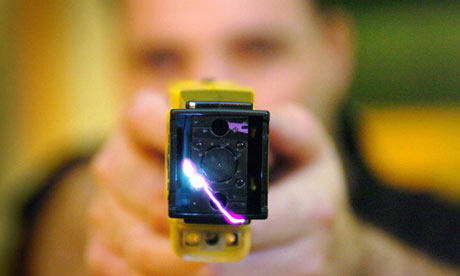
Earlier models of the wired taser, above, delivered a five-second shock. The XREP projectile can deliver a 20-second, 500 volt blow. Photograph: Danny Lawson/PA
A new Taser that fires wireless electric shock projectiles up to 30 metres is being considered for use by UK police forces, the Home Office has confirmed.
The eXtended Range Electronic Projectile (XREP), which went on sale in the US last month, attaches itself to its target with a series of barbed electrodes and delivers a 20-second, 500 volt shock.
If the subject tries to grab the device to pull it off, "reflex engagement electrodes" activate to complete a circuit that sends the shock through the subject's body out to their hand.
The makers of the XREP, Taser International, say it is a "revolutionary" step that will allow police to safely immobilise potentially dangerous suspects from a much greater distance than before – the traditional hand-held Taser stun guns used in the UK only fired darts up to 25 feet – and then give them time to reach the target before he or she is able to move again. Previous Tasers have only delivered a five-second shock, which could be retriggered.
But Amnesty International said it was "seriously concerned" about the XREP and worried by the news it could be authorised in the UK.
"This is effectively a shotgun that fires electric-shock bullets," Amnesty International UK's arms programme director, Oliver Sprague, said, adding: "Because this bullet can be fired wire-free from a standard shotgun there is a heightened risk of causing serious injury to the face and head.
"We're also concerned by the fact that these weapons will deliver an excruciatingly painful shock for 20 seconds. Amnesty would be very alarmed if the Home Office were to consider authorising this weapon to police officers in the UK."
Taser's footage of the device being manually activated on already wired-up volunteers shows them tensing up in pain, groaning and slumping towards the floor.
On the Discovery Channel's Future Weapons programme, one heavily muscled volunteer was asked afterwards how the shock had felt.
"Like my toes curled back to touch my behind," he said. "There's no way I could fight through that."
Rick Smith, Taser International's CEO, told the show the device "can drop the largest, scariest people on the planet".
Last month Taser co-founder Rick Smith told analysts the wireless systems would "leave more of a mark".
"It's a bigger projectile to reach out to extended ranges," he said in a conference call. "It's moving faster; it's going to, potentially, cause a much bigger bruise, contusions. It's going to be a pretty bad thing."
This meant law enforcement would use the devices more sparingly, in only very high risk situations, Smith added.
The Home Office confirmed it was evaluating the XREP for possible use by law enforcement in Britain. "The Home Office Scientific Development Branch are considering it as part of their ongoing remit to evaluate new less lethal technologies" a spokesman said.
Taser rejected Amnesty's concerns, saying the XREP would cause less pain when it hit than other "less lethal" impact munitions and was a safer way to immobilise someone than shooting them with live ammunition.
"The premise behind the XREP is not to cause or impart physical pain, it is to cause incapacitation," spokesman Steve Tuttle said.
"I'm not saying this is risk free: it will leave potential bruising and it could cause a contusion. But when you compare it to a traditional impact munition it will be significantly less likely to cause injury and much more accurate."